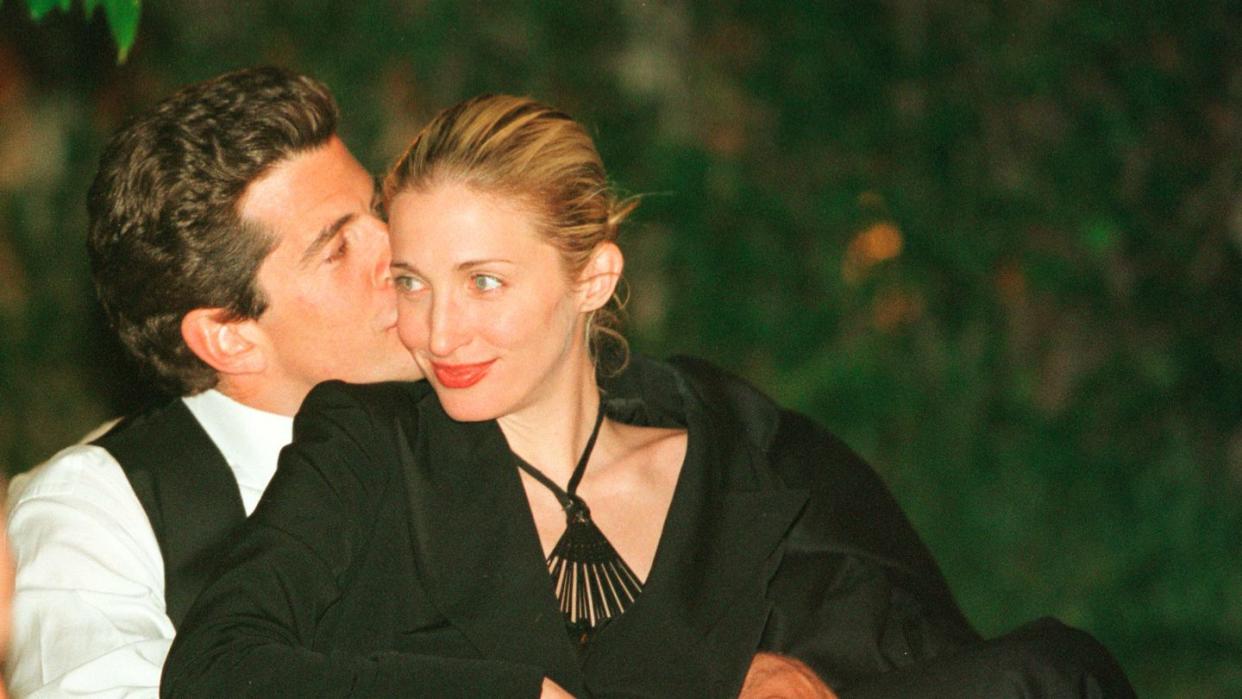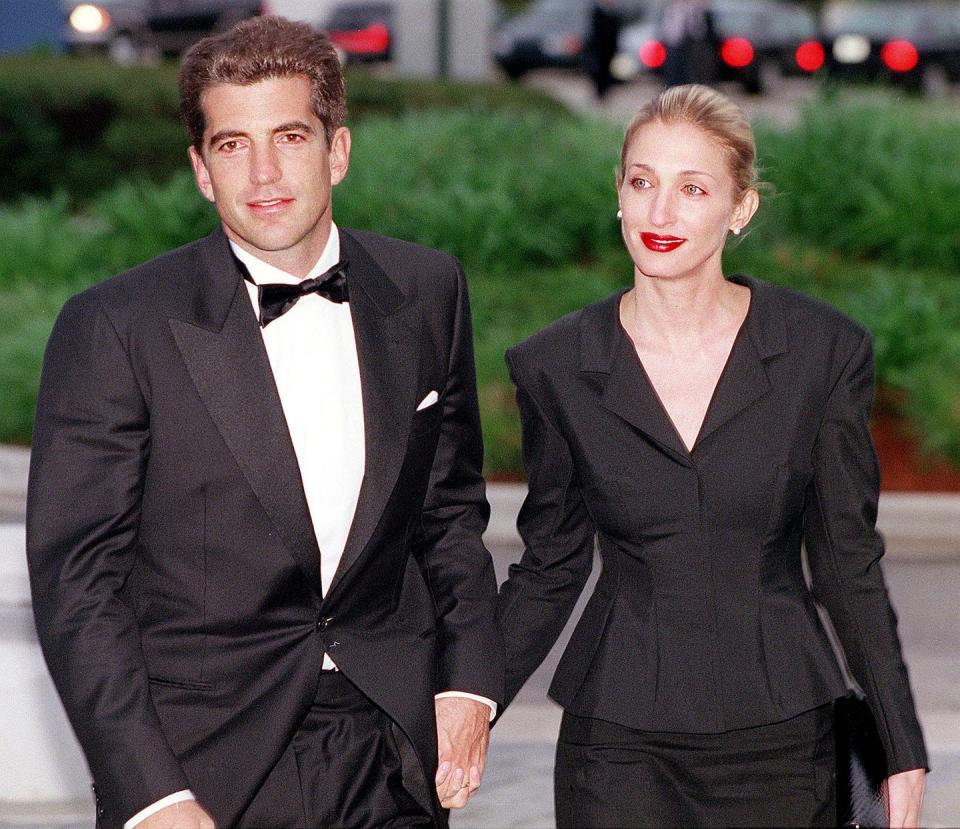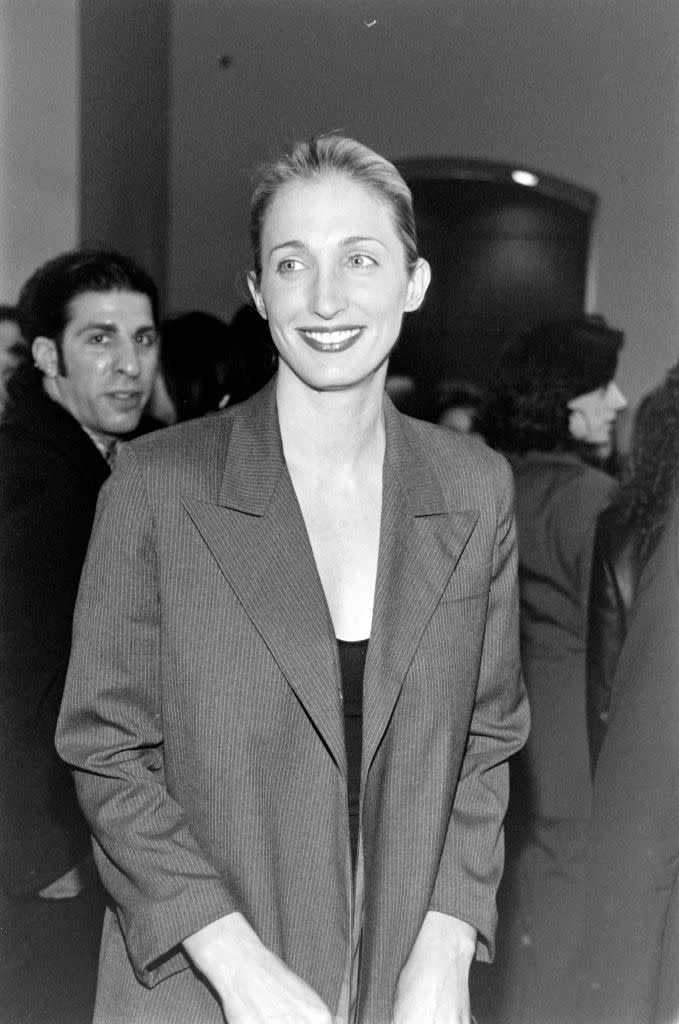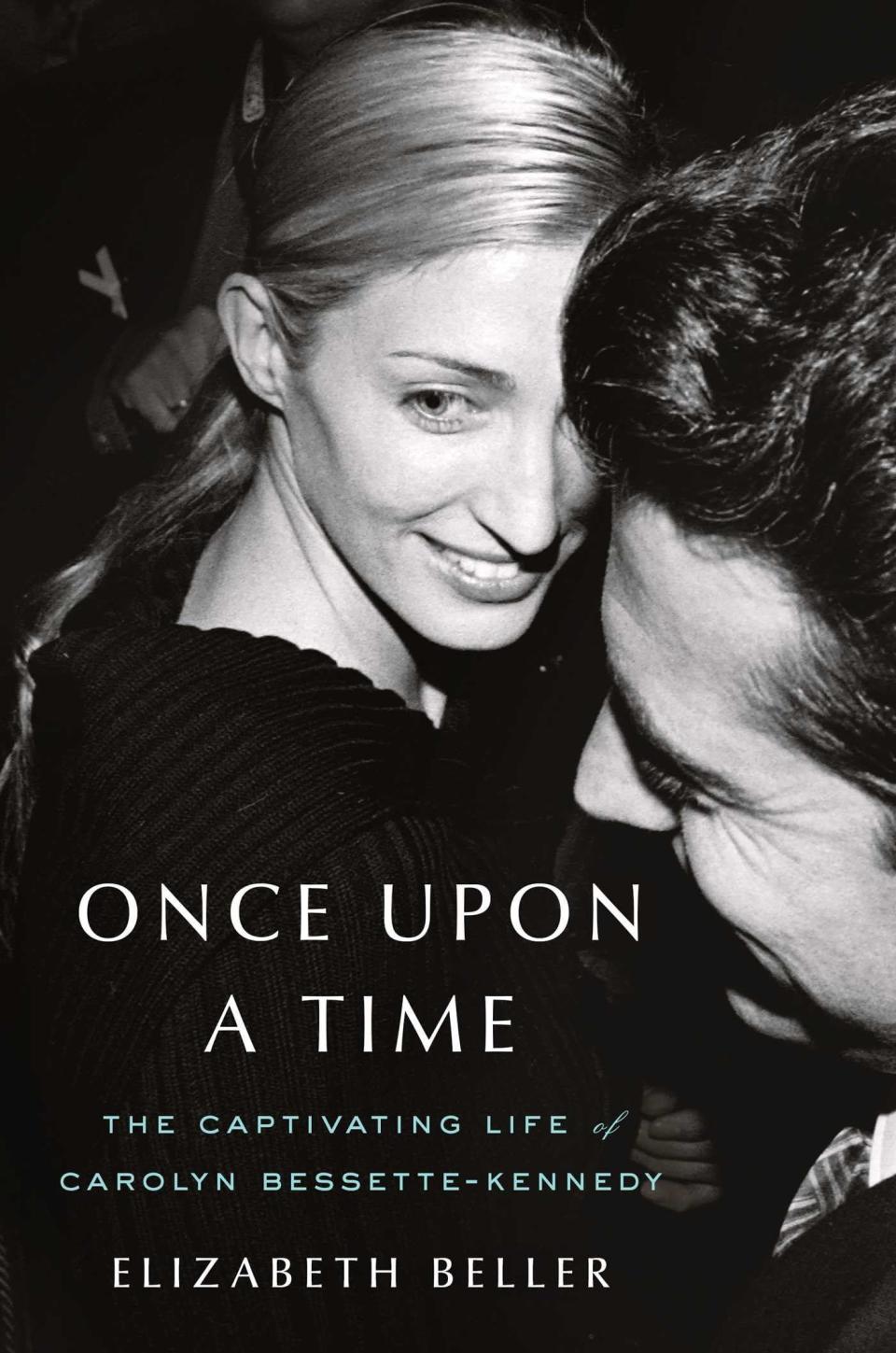A New Book Details the Everlasting Allure of Carolyn Bessette and John F. Kennedy Jr.’s Love Story

- Oops!Something went wrong.Please try again later.
"Hearst Magazines and Yahoo may earn commission or revenue on some items through these links."
Few real-life love stories maintain such a chokehold on pop culture as Carolyn Bessette and John F. Kennedy Jr.’s has. Their union, which began in 1992 (albeit with a few breakups early on) and lasted until their untimely deaths in a plane crash in 1999, boasted the type of societal allure even the most powerful publicists wouldn’t be able to orchestrate.
Even 25 years after their passing, the world still wants to know more about the intensely private (and powerful) couple that reigned over ’90s society. In her new book, Once Upon a Time: The Captivating Life of Carolyn Bessette-Kennedy, Elizabeth Beller paints a more intimate portrait of the late fashion icon and dares to uncover who she was inside and—more importantly—outside her marriage to the prince of Camelot. Through interviews with family, friends, industry peers, and colleagues, readers gain insight into a woman who was ambitious, smart, and intensely wary of fame.
In an exclusive excerpt for Harper’s Bazaar below, Beller details why Bessette and Kennedy worked so well as a couple and how their union was based on vulnerability, trust, and a shared ability to see how they could both individually shape culture and politics at large.
In the fall of 1994, Carolyn and John continued spending most of their free time together. On weekends, he brought her to Central Park for touch football games with college friends like Rob Littell and Richard Wiese. Wiese, who had known Carolyn from downtown hangouts like Au Bar and MK before she and John became official, recalled that one of the things that stood out about Carolyn was her ability to treat John like any other man on the street.
“Carolyn showed up and chirped right back at all those guys bantering while they knocked one another around, including John,” Wiese said. “Nothing got by her, and she enjoyed the repartee as much as anyone. She would stay on the sidelines with John’s German shepherd Sam, and later their high-strung Canaan dog, Friday, calling plays, and teasing everyone mercilessly, laughing. John loved it.”
But behind closed doors, friends knew that Carolyn and John were developing a real kind of intimacy, beyond the playful banter and antics with friends and family. They would spend long, loving evenings confiding profound moments from their lives, and, especially, the subsequent emotional challenges. Carolyn still felt ambivalent about her parents’ divorce; like John, she had been raised Roman Catholic. Though she was sporadically in touch with her father, she also felt left behind. Photographer Stewart Price once noted that Carolyn had confessed to him, “I have these weird daddy issues.”
For his part, John told her about having ADD and dyslexia, and how his mother had moved him from Saint David’s to Collegiate, both all-boys private schools in Manhattan. Overcoming these obstacles required learning specific tools and behaviors. (These were helpful, though not so much they could overcome the ordeal of taking the bar exam sitting in the glass-walled Javits Center while in the crosshairs of photographers just outside.) Jackie felt that Collegiate was better equipped to teach her son how to manage his learning challenges as well as some emotional ones. According to Kennedy biographer Christopher Andersen, there were kids who had taunted him, saying, “Your father’s dead, your father’s dead!” Suffice to say, John was traumatized by the assassination of his father, whom he could scarcely remember, but was grateful to his mother for her focus on her two children while coping with her own PTSD. He regretted the moments he felt he had let her down, such as failing the bar exams—his shame exacerbated by the attendant “The Hunk Flunks” headlines.
John desperately wanted to live up to his mother’s hopes—and everyone’s expectations, including the extended Kennedy family’s as well as the public’s. Gillon documented that Jackie had written him a note just before her death, saying, “I understand the pressure you’ll forever have to endure as a Kennedy, even though we brought you into this world as an innocent. You, especially, have a place in history.” Historian Doug Wead said that Jackie “knew in her heart that, someday, the stars are going to line up, and he’s going to be president.”
John’s predicament as inheritor of the myth of Camelot tugged at Carolyn’s heartstrings. They shared a similar language—that of people who had grown up without fathers, be it from an emotionally absent one, or, in the worst case, a physical loss such as John faced. This could have been one of the many forces that pulled them toward each other—additionally, they had both been raised by loving, devoted mothers.
Carolyn was emotionally strong and caring enough to feel to John like a balm in the aftermath of losing his mother. Like Jackie, she could guide him in nearly every facet of his life. While still holding down a demanding position at Calvin Klein, Carolyn consulted with John on the creation of George magazine. This not only required business acumen and developing an editorial voice, but also the never-ending task of filtering those who wanted proximity to John for their own gain from those who had his best interests at heart. Carolyn’s good instincts about people were indispensable to John. She was looking after him, a real partner in more ways than one.
People changed their behavior when John was around. Some would suddenly jockey for position, or simply lose their cool and turn into a sort of panting sycophant. Carolyn went from surprise to annoyance to indignation at how people would throw themselves at John every time they walked into a room. The problem wasn’t that people were paying attention to him, it was that they demanded attention from him. Carolyn wasn’t just annoyed; it embarrassed her on behalf of the very people behaving so cravenly. She had never engaged in such self-demeaning behavior, and she was shocked and not a little concerned at the lengths people would go just to get his attention.
It was becoming clear that dating John was going to impact Carolyn’s life in bigger ways—both in terms of public optics and her private, everyday existence. Her beautiful, bohemian 112 Waverly Place address had been discovered by the paparazzi that summer, and their constant camping out in front made it impossible for Carolyn to continue living there. Even the Boston Globe chimed in, making sure to mention that she was a Boston University alumna before squawking on, “She recently had to move out of her New York apartment because the press had staked it out and so far, her new location has been kept a pretty good secret.” This was the second move in as many years, and it wouldn’t be her last.

A month or so after bringing her to meet the touch football crew in Central Park, John began to introduce Carolyn to more of his close friends, such as Brown friend and rugby teammate Kenan Siegel and his girlfriend Betsy Reisinger, Dan Samson, whom John had met while volunteer tutoring at the Connecticut Pre-Collegiate Enrichment Program, and finally, properly, to fellow Andover alum Sasha Chermayeff at a mellow home dinner, after having her “check Carolyn out” two-plus years earlier at the Don’t Bungle the Jungle II benefit. All of them loved her immediately, and Littell was particularly taken not just with her beauty, but her entire persona. “It was obvious that she was as bright a star as John,” he wrote. “And it wasn’t just because of her fierce, compelling beauty. It was because she seemed to look right into your soul, and then wink.”
Carolyn introduced John to her friends from the fashion industry such as Narciso Rodriguez, Gordon Henderson, Jules Watson, and MJ Bettenhausen, who owns the Tribeca creative imaging agency, P2P Group. Bettenhausen, it turned out, had known John for a few years from various events in the city. So she had a unique perspective when she first saw them together. “What was most noticeable about them was how much they laughed together. It was striking,” she noted. “Carolyn had always been full of joie de vivre, but depending on the company, John could sometimes be more introverted. Carolyn brought out his joy.”
“[Carolyn] and John made few public appearances,” said John’s Andover friend Billy Way, “because any function they attended automatically assumed the proportions of a major event. When they did appear in public, John took it upon himself to protect her.”
John’s friend actor Jack Merrill and Carolyn immediately appreciated each other as people who were in John’s life for authentic friendship, but also ones who would help John keep the would-be groupies at bay. But while for Jack this deflecting was a once-in-a-while gig, for Carolyn it became a full-time necessity because, as Jack put it, “John always had people coming at him, and it’s hard to explain, but she and I knew when to pull in the wagons close, in a way that wasn’t rude, and he could feel at least a little safer. I think most of his best friends knew instinctively how to do that.”
Carolyn managed to stay centered amid the obsessional chaos in which she found herself thanks to her coterie of good friends and her dedication to her job at Calvin Klein.
“I remember Carolyn’s work ethic,” Merrill said. “She was 100 percent on top of things. She would wake up at 6:00 a.m. to do paperwork before heading to the office.”

Carolyn, at this juncture, had worked at Calvin Klein for five years, starting as a salesgirl in a store in Boston, moving to New York to work as a bespoke salesperson for VIPs, and then onward and upward to public relations. Now, at age 28, she was a publicist and a producer at one of the most prominent fashion labels in the world. Her confidence in her abilities had grown along with her accomplishments. She was able to navigate the warp-speed-paced fashion industry that catered to frequently outlandish celebrity demands, and, perhaps most importantly, she understood her talent with fellow human beings. It was at this time that she confided to Reisinger exactly what it was. “I know this sounds odd,” Carolyn told her, “but I can always feel what everyone is feeling. Before I talk to them, I can tell.”
With such faith in her instincts about people, and with such savvy and success in her career and other relationships—it’s no wonder that Carolyn thought she could handle dating John F. Kennedy Jr.
From ONCE UPON A TIME: The Captivating Life of Carolyn Bessette-Kennedy. Copyright 2024 by Elizabeth Beller. Reprinted by permission of Gallery Books, An Imprint of Simon & Schuster, LLC.

Once Upon a Time: The Captivating Life of Carolyn Bessette-Kennedy
amazon.com
$14.99
You Might Also Like

